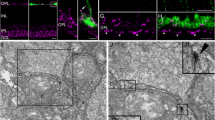Summary
Studies on gap junctions isolated from rat liver by a procedure that avoids exogenous proteolysis (Hertzberg, E. L.; Gilula, N. B.; J. Biol. Chem. 254: 2138–2147; 1979) are described. The original isolation procedure was modified to increase the yield and has been extended to the preparation of gap junctions from mouse and bovine liver. Peptide map studies showed that the 27,000-dalton polypeptides present in liver gap junction preparations from all three sources are homologous and are not derived from other polypeptides of higher molecular weight that are observed in cruder preparations. Similar studies with lens fiber junctions demonstrated no homology between liver and lens junction polypeptides. Antibodies to the lens junction polypeptide did not cross-react with the liver gap junction polypeptide, further supporting this conclusion.
Similar content being viewed by others
References
Pitts, J. D. Junctional communication, and cellular growth control. Feldman, J.; Gilula, N. B.; Pitts, J. D. eds. Intercellular junctions and synapses. London: Chapman and Hall; 1978; 61–80.
Wolpert, L. Gap junctions; channels for communication in development. Feldman, J.; Gilula, N. B.; Pitts, J. D. eds.. Intercellular, junctions and synapses. London: Chapman and Hall; 1978; 83–94.
Loewenstein, W. R.. Junctional intercellular communications and the control of growth. Biochem. Biophys. Acta 560: 1–65; 1979.
Lawrence, T. S.; Beers, W. H.; Gilula, N. B. Transmission of hormonal stimulation by cell-to-cell communication. Nature 272; 501–506; 1978.
Rose, B.; Simpson, I.; Loewenstein, W. R. Calcium ion produces graded changes in permeability of membrane channels in cell junction. Nature 267: 625–627; 1977.
Flagg-Newton, J.; Simpson, I.; Lowenstein, W. R. Permeabilityof the cell-to-cell membrane channels in mammalian cell junction. Science 205: 404–407; 1979.
Turin, L.; Warner, A. E.. Intracellular pH in, earlyXenopusembryos: its effect on current flow between blastomeres. J. Physiol. (Lond.) 300: 489–504; 1980.
Spray, D. C.; Harris, A. L.; Bennett, M. V. L. Voltage dependence of junctional conductance in early amphibian embryos. Science 204: 432–434; 1979.
Revel, J.-P.; Yancey, B.; Meyer, D. Cell junctions and intercellular communication (abstr.). In Vitro 16: 203; 1980.
Kuriyama, H.; Suzuki, H. Changes in electrical properties of rat myometrium during, gestation and following hormonal treatments. J. Physiol. (Lond.) 260: 315–333; 1976.
Caspar, D. L. D.; Goodenough, D. A.; Makowski, L.; Phillips, W. C. Gap junction structures. I. Correlated electron microscopy and x-ray diffraction. j. Cell Biol. 74: 605–628; 1977.
Makowski, L.; Caspar, D. L. D.; Phillip, W. C.; Goodenough, D. A. Gap junction structures. II. Analysis of the X-ray diffraction data. J. Cell Biol. 74: 629–645; 1977.
Zampighi, G.; Unwin, P. N. T. Two forms of isolated gap junctions. J. Mol. Biol. 135: 451–464; 1979.
Unwin, P. N. T.; Zampighi, G. Structure of the junction between communicating cells. Nature 283: 545–549; 1980.
Goodenough, D. A.; Stoeckenius, W. The isolation of mouse hepatocyte gap junctions. Preliminary chemical characterization and X-ray diffraction. J. Cell Biol. 54: 646–656; 1972.
Evans, W. H.; Gurd, J. W.. Preparation and properties of nexuses and lipid-enriched vesicles from mouse liver plasma membranes. Biochem. J. 128: 691–700; 1972.
Benedetti, E. L.; Emmelot, P. Hexagonal array of subunits in tight junctions separated from isolated rat liver plasma membranes. J. Cell Biol. 38: 15–24; 1968.
Duguid, J. R.; Revel, J.-P. The protein components the gap junctions. Cold Spring Harbor Symp. Quant. Biol. 40: 45–47; 1975.
Culvenor, J. G.; Evans, W. H. Preparation of hepatic gap (communicating) junctions. Identification of the constituent polypeptide subunits. Biochem. J. 168; 475–481: 1977.
Ehrhard, J.-C.; Chauveau, J. The protein component of mouse hepatocyte gap junctions. FEBS Lett. 78: 295–299; 1977.
Hertzberg, E. L.; Gilula, N. B. Isolation and characterization of gap junctions from rat liver. J. Biol. Chem. 254: 2138–2147; 1979.
Henderson, D.; Eibl, H.; Weber, K. Structure and biochemistry of mouse hepatic gap junctions. J. Mol. Biol. 132: 193–218; 1979.
Finbow, M.; Yancey, B.; Jonson, R.; Revel, J.-P. Independent lines of evidence suggesting a major gap junctional protein with molecular weight of 26,000. Proc. Natl. Acad. Sci. USA 77: 970–974; 1980.
Bloemendal, H. The vertebrate eye lens. Science 179; 127–138; 1977.
Alcala, J.; Lieska, N.; Maisel, H. Protein composition of bovine lens cortical fiber cell membranes. Exp. Eye Res. 21: 581–595; 1975.
Broekhuyse, R. M.; Kuhlmann, E. D.; Stols, A. L. H. Lens membranes II. Isolation and characterization of the main intrinsic polypeptide (MIP) of bovine lens fiber membranes. Exp. Eye Res. 23: 365–371; 1976.
Goodenough, D. A. Lens gap junctions: A structural hypothesis for nonregulated low-resistance intercellular pathways. Invest. Ophthalmol. 18: 1104–1122; 1979.
Laemmli, U. K.; Favre, M. Maturation of the head of bacteriophage T4. I. DNA packaging events. J. Mol. biol. 80: 575–599; 1973.
Cleveland, D. W.; Fischer, S. G.; Kirschner, M. W.; Laemmli, U. K. Peptide mapping by limited proteolysis in sodium dodecyl sulfate and analysis by gel electrophoresis. J. Biol. Chem. 252: 1102–1106; 1977.
Bordier, C.; Crettol-Jarvinen, A. Peptide mapping of heterogeneous protein samples. J. Biol. Chem. 254: 2565–2567; 1979.
Kagawa, Y.; Racker, E. Partial resolution of the enzymes catalyzing oxidative phosphorylation. XXV. Reconstruction of vescles catalyzing32P1 adenosine triphosphate exchange. J. Biol. Chem. 246: 5477–5487; 1971.
Engelhard, V. H.; Guild, B. C.; Helenius, A.; Terhorst, C.; Strominger, J. Reconstitution of purified detergent-soluble HLA-A and HLA-B antigens into phospholipid vesicles. Proc. Natl. Acad. Sci. USA 75: 3230–3234; 1978.
Branton, D. Fracture faces of frozen membranes. Proc. Natl. Acad. Sci. USA 55: 1048–1056; 1966.
Michalke, W.; Loewenstein, W. R. Communication between cells of different types. Nature 232; 121–122; 1971.
Epstein, M. L.; Gilula, N. B. A study of communication specificity between cells in cultures. J. Cell Biol. 75: 769–787; 1977.
Author information
Authors and Affiliations
Additional information
This symposium was supported in part by Contract 263-MD-025754 from the National Cancer Institute and the Fogarty International Center.
Research in the laboratory was supported by grants to Dr. Gilula from the National Institute of Health (HL 16507 and GM 24753).
Rights and permissions
About this article
Cite this article
Hertzberg, E.L. Biochemical and immunological approaches to the study of gap junctional communication. In Vitro 16, 1057–1067 (1980). https://doi.org/10.1007/BF02619256
Issue Date:
DOI: https://doi.org/10.1007/BF02619256




